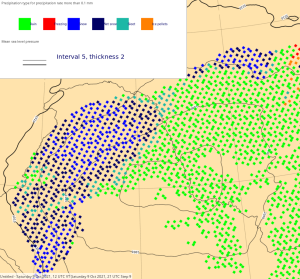...
Although ECMWF has used both systematic and case study analyses to document the most significant and substantial changes for users, the list below can not be considered exhaustive - other features may well come to light in the coming months.
On 11th October 2021 new text was added to this web page, shown in green. A few additional figures were also added nearby.
...
Precipitation
A large set of cases in different "synoptic type" categories where precipitation tends to occur were examined; these included orographic rainfall (convective, large-scale, mix), cold fronts, warm fronts, diurnal convection over land, SST-triggered convection, tropical convection, MCSs (mesoscale convective systems). In almost all of these classes the precipitation rate patterns look to be systematically different in 47r3.
...
"Mixed picture" means marked regional variations. The maximum change at any location in any of these classes is about 15%.
Regional average changes, over summer and winter seasons, at a 48-hour lead time, are illustrated on the following plot (warm colours mean more cloud in 47r3).
High cloud in particular tends to show more sharply defined edges in 47r3. The example below highlights far more areas of cloud cover >99% (i.e. >0.99), and similarly a much reduced spatial coverage of areas with 50-99% cover. It should be added that the non-opaque nature of high cloud makes defining full cover in a meaningful way rather difficult.
...
The plots below, from a day with heavy rain in NW Europe, nicely illustrate point 2 above (plots of rainfall rate with mslp are added in each case as a reference point). One can also see that any counteracting effect of the highest rainfall rates tending to be even higher in 47r3 is negligible by comparison.
The following panels compare visibility in an October case with snow and rain centred on northernmost China. Cycle 47r3 shows lower values overall in the snow than in the rain; this looks more realistic than 47r2 which has the opposite.
| Diagnosed Ppn type | Total Precipitation Rate | Total Snowfall Rate | Visibility | |
47r2 (old cycle) | ||||
47r3 (new cycle) |
...












